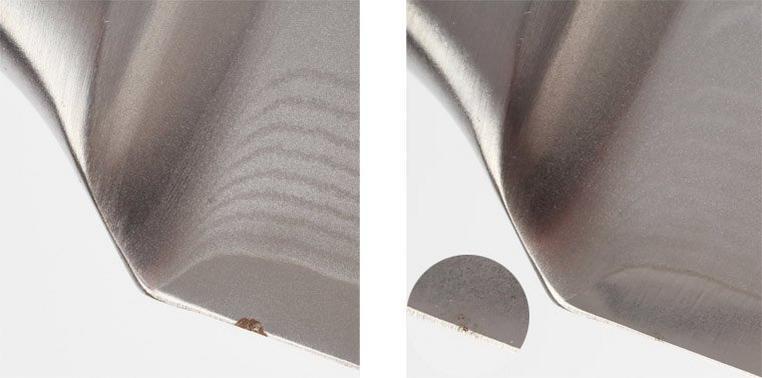Rust spots on kitchen knives
Question to Knivesandtools:
I can see little specks of rust on my stainless steel kitchen knives. How is that possible? They are made from stainless steel and they were absolutely not cheap either!
Answer of Knivesandtools:
These specks of rust are usually caused by pit corrosion. Pit corrosion is the most common type of corrosion in kitchen knives of stainless steel.
In hard knives with high carbon content, like knives of VG10 steel and the Twin Cermax knives, pit corrosion is most common. However, pit corrosion also occurs in knives of ‘ordinary’ stainless knife steel.
Are those knives bad? No, a good knife is a compromise and the best cutting characteristics the knife should have you unfortunately must compromise on sensitivity to rust.
If you know this and act accordingly, all is well.
Background of pit corrosion
Stainless steel is steel that does not oxidise at air humidity up to 70%. That is achieved by adding approx. 15% chrome to the steel. The chrome forms a thin layer of chrome oxide that closes off and protects the steel against corrosion by exposure to the air.
When the layer of chrome oxide is damaged, a new layer is normally formed. In itself nothing is happening then.
It does become a problem if the steel does not get the chance to form that new layer. That happens if the environment is moist (or wet). Small damage to the chrome oxide layer + a water drop is the reason for pit corrosion. The result can be clearly seen on the picture. A small black fleck surrounded by a ring of rust.
Like we said the chrome oxide layer must first be damaged before pit corrosion occurs. That damage can have a mechanical cause (collision with something hard) but a chemical too. Dish washing detergent food acids and contact with other types of steel can easily affect the chromoxide layer.
In the photo here water has extracted acid from the wooden handle and therefore the pit corrosion has started precisely on the transition from wood to steel.
Removing pit corrosion
The spot of rust generated around the pit can be easily removed with a soft cloth and a bit of abrasive like CIF. As you can see above a little pit is left but if you keep your knives dry all is well.
Preventing pit corrosion
Pit corrosion is easy to prevent if you keep to the following rules:
- Clean and dry your knives immediately after use
- Never put your knives in the dishwasher. Salt, humidity and heat are a disaster for your knife
- Never leave your wet knife in a sink or on a work surface
- Sharpen your knives from time to time. That prevents pit corrosion on the cutting edge
Very strange!
It is strange that people who complain about pit corrosion never place their knives in the dishwasher and always clean, dry and store their knives after use. When you know that a drop of water is required to move the rust of the pit to the place around it and that takes a long time, it is a highly unlikely story.
Here is our tip: make sure that your housemates know how to deal with a knife and remember it is a very expensive knife and that a very expensive knife can be more sensitive to rust than the cheap knife from the supermarket!








